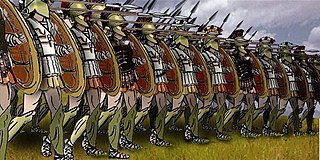A Roman legion(romanum legio) was a large unit of the Roman army.

The Battle of Zama—fought in 202 BC near Zama (Tunisia)—marked the end of the Second Punic War. A Roman army led by Publius Cornelius Scipio Africanus (Scipio), with crucial support from Numidian leader Masinissa, defeated the Carthaginian army led by Hannibal.
Maniple was a tactical unit of the Roman legion adopted during the Samnite Wars. It was also the name of the military insignia carried by such unit.

The Marian reforms of 107 BC were a group of military reforms initiated by Gaius Marius, a statesman and general of the Roman Republic.
Hasta is a Latin word meaning "spear". Hastae were carried by early Roman legionaries, in particular they were carried by and gave their name to those Roman soldiers known as hastati. However, during republican times, the hastati were re-armed with pila and gladii and the hasta was only retained by the triarii.
As the Roman kingdom successfully overcame opposition from the Italic hill tribes, and became a larger state, the age of tyranny in the easteiiMediterranean began to subside. Inspired by the idea of new constitutions arising there, the Roman populace threw off the yoke of tyranny and established a republic. The army was now facing threats from all of Europe and could only respond through change. This article covers the military establishment of the Roman Republic. For previous changes in the Roman army, see military establishment of the Roman kingdom.
The term Accensi is applied to two different groups. Originally, the accensi were light infantry in the armies of the early Roman Republic. They were the poorest men in the legion, and could not afford much equipment. They did not wear armour or carry shields, and their usual position was part of the third battle line. They fought in a loose formation, supporting the heavier troops. They were eventually phased out by the time of Second Punic War. In the later Roman Republic the term was used for civil servants who assisted the elected magistrates, particularly in the courts, where they acted as ushers and clerks.

The Battle of the Great Plains, also known as the Battle of the Bagrades, was a battle fought between Scipio Africanus of Rome and a combined Carthaginian and Numidian army late in the Second Punic War. It occurred on the plains south of Bulla Regia around the upper Bagradas River. The attack was designed as diversionary tactic by Rome to disrupt Hannibal's attack on Italy. By defeating the Carthaginians, Scipio Africanus caused Hannibal to leave Italy and return to Africa, where he was later defeated at Zama.

Heavy infantry refers to heavily armed and armoured infantrymen that were trained to mount frontal assaults and/or anchor the defensive center of a battle line. This differentiated them from light infantry which are relatively mobile and lightly armoured skirmisher troops intended for screening, scouting, and other roles unsuited to the heavier soldiers.
Velites were a class of infantry in the Roman army of the mid-Republic from 211 to 107 BC. Velites were light infantry and skirmishers who were armed with a number of darts, each with a 30-inch wooden shaft the diameter of a finger, with a c. 10-inch narrow metal point, to fling at the enemy. They also carried short thrusting swords, or gladii, for use in melee. They rarely wore armour as they were the youngest and poorest soldiers in the legion and could not afford much equipment. They did carry small wooden shields called parma for protection, and wore headdresses made from wolf skins so their brave deeds could be recognized. The velites were placed at the front partly for tactical reasons, and also so that they had the opportunity to secure glory for themselves in single combat.
Hastati were a class of infantry employed in the armies of the early Roman Republic who originally fought as spearmen, and later as swordsmen. These soldiers were the staple unit after Rome threw off Etruscan rule. They were originally some of the poorest men in the legion, and could afford only modest equipment—light chainmail and other miscellaneous equipment. The Senate supplied their soldiers with only a short stabbing sword, the gladius, and their distinctive squared shield, the scutum. The hastatus was typically equipped with these, and one or two soft iron tipped throwing spears called pila. This doubled their effectiveness, not only as a strong leading edge to their maniple, but also as a stand-alone missile troop. Later, the hastati contained the younger men rather than just the poorer, though most men of their age were relatively poor. Their usual position was the first battle line. They fought in a quincunx formation, supported by lighter infantry. The enemy was allowed to penetrate the first battle line consisting of hastati, after which the enemy would deal with the more hardened, seasoned soldiers, the principes. They were eventually disbanded after the Marian reforms of 107 BC.
Principes were spearmen, and later swordsmen, in the armies of the early Roman Republic. They were men in the prime of their lives who were fairly wealthy, and could afford decent equipment. They were the heavier infantry of the legion who carried large shields and wore good quality armor.

Triarii were one of the elements of the early Roman military manipular legions of the early Roman Republic. They were the oldest and among the wealthiest men in the army and could afford high quality equipment. They wore heavy metal armor and carried large shields, their usual position being the third battle line. They were equipped with spears and were considered to be elite soldiers among the legion.

Belemnites is a genus of an extinct group of cephalopods belonging to the order Belemnitida. These cephalopods existed in the Early Jurassic period from the Hettangian age to the Toarcian age (175.6–183.0). They were fast-moving nektonic carnivores.
A Hastiliarius was a weapons instructor in the Roman Empire. They trained raw troops with standard weapons and fighting techniques of the Roman Empire.
Calliini is a tribe of longhorn beetles of the Lamiinae subfamily.
Hastatis is a genus of longhorn beetles of the subfamily Lamiinae.
Hastatis auricollis is a species of beetle in the family Cerambycidae. It was described by Buquet in 1857. It is known from Brazil.
Mauesia simplicis is a species of beetle in the family Cerambycidae. It was described by Moyses and Galileo in 2009.
Anobrium simplicis is a species of beetle in the family Cerambycidae. It was described by Galileo and Martins in 2002. It is known from Brazil.







